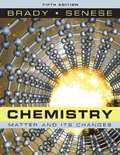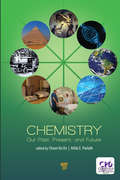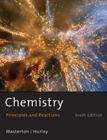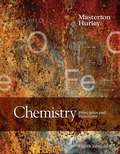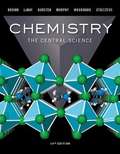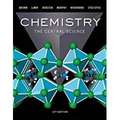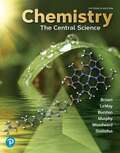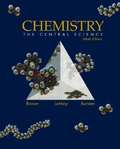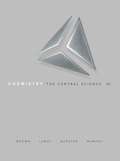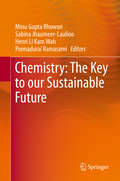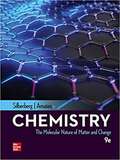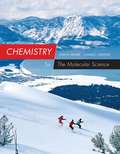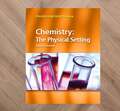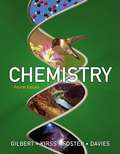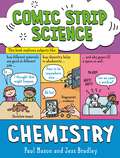- Table View
- List View
Chemistry: Matter and Change
by Laurel Dingrando Nicholas Hainen Kathleen TallmanMeets All California State Standards!Glencoe CaliforniaChemistry: Matter and Changecombines the elements students need to succeed! A comprehensive course of study designed for a first-year high school chemistry curriculum, this program incorporates features for strong math support and problem-solving development. Promote strong inquiry learning with a variety of in-text lab options, including Discovery Labs, MiniLabs, Problem-Solving Labs, and ChemLabs (large- and small-scale), in addition to Forensics, Probeware, Small-Scale, and Lab Manuals. Provide simple, inexpensive, safe chemistry activities with Try at Home labs. Unique to Glencoe, these labs are safe enough to be completed outside the classroom and are referenced in the appropriate chapters!
Chemistry: Matter and Change (Oklahoma)
by Thandi Buthelezi Laurel Dingrando Nicholas HainenChemistry: Matter and Change is a comprehensive chemistry course of study, designed to for a first year high school chemistry curriculum. The program incorporates features for strong math support and problem-solving development. The content for the 2005 revision has been reviewed for accuracy. This program offers new “Try At Home” labs in the student edition. A new Science Notebook ancillary has been developed to assist students, lesson-by-lesson, in comprehending the main idea. Significant enhancements have been made to the program’s technology support.
Chemistry: Matters and Its Changes
by James E. Brady Fred Senese Neil D. JespersenWritten by Jim Brady, an author well known for his ability to communicate chemistry, and Fred Senese, the architect of the most visited general chemistry Web site, this book and its media are designed to support a variety of backgrounds.
Chemistry: Our Past, Present, and Future
by Attila E. PavlathThis book discusses the vital role of chemistry in everyday life. It encourages readers to understand how the knowledge of chemistry is important for the development of society and a better future. The text is organized into three parts. Part 1 covers the historical aspects of chemistry and discusses how countless discoveries since the beginning of life on earth have benefited human beings. Part 2 focuses on modern life and describes chemistry’s contribution to the developments in the fields of food and agriculture, energy, transportation, medicine, and communications. Part 3 emphasizes the role of chemists and educators in making the layperson aware of the benefits of chemistry without having them to go through its complexities. Written in an easy-to-understand manner and supplemented by ample number of figures and tables, the book will cater to a broad readership ranging from general readers to experts.
Chemistry: Precision & Design (3rd Edition)
by The Editors at the Beka BookThis book provides a foundational knowledge of chemistry, an appreciation of how chemistry benefits mankind, and a better understanding of the precision and design in the physical world that God created.This book is intended to adequately prepare students for college-level chemistry courses while remaining comprehensible to all students.
Chemistry: Principles and Reactions
by Cecile N. Hurley William L. MastertonThis textbook outlines the principles that govern chemical reactions and continuously illustrates their usefulness in practical applications. The authors (University of Connecticut) cover reactions in aqueous solutions, the ideal gas law, electron arrangements, rate of reaction, acid-base solutions, and complex ions. The sixth edition replaces 30% of the in-text examples, adds four research essays, and updates molecular models. Annotation ©2008 Book News, Inc., Portland, OR (booknews.com)
Chemistry: Principles and Reactions
by Cecile N. Hurley William L. MastertonThis textbook outlines the principles that govern chemical reactions and continuously illustrates their usefulness in practical applications. The authors (U. of Connecticut) explain reactions in aqueous solutions, the ideal gas law, electron arrangements, rate of reaction, acid-base solutions, and basic organic chemistry. The seventh edition employs a two-column format for examples, adds colorful flowcharts, and combines the chapters on complex ion and precipitation equilibrium. Online support includes interactive examples with OWL (Online Web Learning) and 27 Go Chemistry tutorial videos with mini-lectures of five to ten minutes linked to specific sections of the text. Annotation ©2011 Book News, Inc. , Portland, OR (booknews. com)
Chemistry: Principles and Reactions
by Cecile N. Hurley William L. MastertonDiscover all of the fundamental topics of general chemistry with this brief, reader-oriented book. CHEMISTRY: PRINCIPLES AND REACTIONS, 8e, provides a clear, concise presentation based on the authors' more than 50 years of combined teaching experience. The book includes graded and concept-driven examples as well as examples that focus on molecular reasoning and understanding, as well as "Chemistry: Beyond the Classroom" essays that demonstrate the relevance of the concepts and highlight some of the most up-to-date uses of chemistry. A strong, enhanced art program helps readers visualize chemical concepts. Integrated end-of-chapter questions and Key Concepts correlate to OWLv2, the #1 online homework and tutorial system for chemistry.
Chemistry: The Central Science
by Patrick Woodward Theodore E. Brown Catherine Murphy H. LeMay Bruce Bursten Matthew StoltzfusUnrivaled problem sets, notable scientific accuracy and currency, and remarkable clarity have made Chemistry: The Central Science the leading general chemistry text for more than a decade. Trusted, innovative, and calibrated, the text increases conceptual understanding and leads to greater student success in general chemistry by building on the expertise of the dynamic author team of leading researchers and award-winning teachers. <p><p> In this new edition, the author team draws on the wealth of student data in Mastering™ Chemistry to identify where students struggle and strives to perfect the clarity and effectiveness of the text, the art, and the exercises while addressing student misconceptions and encouraging thinking about the practical, real-world use of chemistry. New levels of student interactivity and engagement are made possible through the enhanced eText 2.0 and Mastering Chemistry, providing seamlessly integrated videos and personalized learning throughout the course .
Chemistry: The Central Science
by Bruce E. Bursten Patrick Woodward Theodore E. Brown Catherine Murphy H. Eugene LeMayChemistry: The Central Science are delighted and honored that you have chosen us as your instructional partners for your general chemistry class. Collectively we have taught general chemistry to multiple generations of students. So we understand the challenges and opportunities of teaching a class that so many students take. We have also been active research¬ers who appreciate both the learning and the discovery aspects of the chemical sciences. Our varied, wide-ranging experiences have formed the basis of the close collaborations we have enjoyed as coauthors. In writing our book, our focus is on the students: we try to ensure that the text is not only accurate and up-to-date but also clear and readable. We strive to convey the breadth of chemistry and the excitement that scientists experience in mak¬ing new discoveries that contribute to our understanding of the physical world. We want the student to appreciate that chemis¬try is not a body of specialized knowledge that is separate from most aspects of modern life, but central to any attempt to address a host of societal concerns, including renewable energy, environ¬mental sustainability, and improved human health.
Chemistry: The Central Science
by Theodore L. Brown Catherine J. Murphy Jr. H. Eugene LeMay Bruce E. Busten Matthew W. Stoltzfus Patrick M. WoodwardBuilt for student success in general chemistry Chemistry: The Central Science approaches general chemistry with unrivaled problem sets, scientific accuracy, currency and clarity. The author team's expertise and experience as leading researchers and award-winning teachers guide students to develop conceptual understanding and think about the real-world use of chemistry. The 15th Edition makes learning chemistry more effective than ever with new student-friendly learning objectives and follow-up self-assessment exercises. New descriptions of problem-solving strategies and revised end-of-chapter problems enhance student understanding of chemistry.
Chemistry: The Central Science
by H. Eugene Lemay Theodore E. Brown Julia R. Burdge Bruce Edward BurstenThe acknowledged leader and standard in general chemistry, this book maintains its effective and proven features--clarity of writing, scientific integrity, currency, strong exercises, visual emphasis and consistency in presentation. It offers readers an integrated educational solution to the challenges of the learning with an expanded media program that works in concert with the book, helping them to approach problem solving, visualization, and applications with greater success.
Chemistry: The Central Science (Mastering Chemistry)
by Bruce E. Bursten Catherine J. Murphy Patrick Woodward H. Eugene H. LeMay Theodore BrownTrusted, innovative, and calibrated, Chemistry: The Central Science has helped millions of students understand and succeed in general chemistry. Its unrivaled problems, scientific accuracy, and clarity are maintained in this new edition, which is the book's biggest revision to date. In the Twelfth Edition, every word and piece of art has been studied for effectiveness. Based on feedback from students like you, this revision reflects the unparalleled expertise of its author team; each chapter has been updated and streamlined to remove any content not proven to increase student comprehension. Joined in this edition by new co-author Patrick Woodward, the book's solid authorship gains a fresh, new perspective yet maintains its unified, consistent voice. Chemistry: The Central Science continues to improve student success beyond the text with MasteringChemistry®, the most advanced online tutorial and assessment program available. Used by over a million science students, the Mastering platform is the most effective and widely used online tutorial, homework, and assessment system for the sciences. This is the product access code card for MasteringChemistry ® and does not include the actual bound book. Pearson eText gives students access to the text whenever and wherever they can access the Internet. The eText pages look exactly like the printed text, and include powerful interactive and customization functions. This is the access code card for Pearson eText and does not include the actual bound book.
Chemistry: The Key To Our Sustainable Future
by Henri Li Kam Wah Ponnadurai Ramasami Minu Gupta Bhowon Sabina Jhaumeer-LaullooChemistry: The Key to our Sustainable Future is a collection of selected contributed papers by participants of the International Conference on Pure and Applied Chemistry (ICPAC 2012) on the theme of "Chemistry: The Key for our Future" held in Mauritius in July 2012. In light of the significant contribution of chemistry to benefit of mankind, this book is a collection of recent results generated from research in chemistry and interdisciplinary areas. It covers topics ranging from nanotechnology, natural product chemistry to analytical and environmental chemistry. Chemistry: The Key to our Sustainable Future is written for graduates, postgraduates, researchers in industry and academia who have an interest in the fields ranging from fundamental to applied chemistry.
Chemistry: The Molecular Nature Of Matter And Change
by Martin Silberberg Patricia AmateisChemistry: The Molecular Nature of Matter and Change by Martin Silberberg and Patricia Amateis has been recognized in the general chemistry market as an unparalleled classic. The revision for the eighth edition focused on continued optimization of the text. <p><p> To aid in this process, we were able to use data from literally thousands of student responses to questions in LearnSmart, the adaptive learning system that assesses student knowledge of course content. The data, such as average time spent answering each question and the percentage of students who correctly answered the question on the first attempt, revealed the learning objectives that students found particularly difficult, which we addressed by revising surrounding text or adding additional learning resources such as videos and slideshows. <p> The text still contains unprecedented macroscopic-to-microscopic molecular illustrations, consistent step-by-step worked exercises in every chapter, and an extensive range of end-of-chapter problems, which provide engaging applications covering a wide variety of interests, including engineering, medicine, materials, and environmental studies. <p> Changes have been made to the text and applications throughout to make them more succinct, to the artwork to make it more teachable and modern, and to the design to make it more simplistic and open.
Chemistry: The Molecular Nature of Matter and Change
by Martin S. SilberbergWith each edition,Chemistry: The Molecular Nature of Matter and Changeby Martin Silberberg is becoming a favorite among faculty and students. Silberberg's 5th edition contains features that make it the most comprehensive and relevant text for any student enrolled in a general chemistry course. The text contains unprecedented macroscopic to microscopic molecular illustrations, consistent step-by-step worked exercises in every chapter, and an extensive range of end-of-chapter problems which provide engaging applications covering a wide variety of freshman interests, including engineering, medicine, materials, and environmental studies. All of these qualities makeChemistry: The Molecular Nature of Matter and Changethe centerpiece for any General Chemistry course.
Chemistry: The Molecular Nature of Matter and Change
by Martin Silberberg Patricia AmateisChemistry: The Molecular Nature of Matter and Change by Martin Silberberg and Patricia Amate is has been recognized in the general chemistry market as an unparalleled classic. The revision for the ninth edition focused on continued optimization of the text. <p><p>To aid in this process, we were able to use data from literally thousands of student responses to questions in LearnSmart, the adaptive learning system that assesses student knowledge of course content. The data, such as average time spent answering each question and the percentage of students who correctly answered the question on the first attempt, revealed the learning objectives that students found particularly difficult, which we addressed by revising surrounding text or adding additional learning resources such as videos and slideshows. <p><p>The text still contains unprecedented macroscopic-to-microscopic molecular illustrations, consistent step-by-step worked exercises in every chapter, and an extensive range of end-of-chapter problems, which provide engaging applications covering a wide variety of interests, including engineering, medicine, materials, and environmental studies. Changes have been made to the text and applications throughout to make them more succinct, to the artwork to make it more teachable and modern, and to the design to make it more simplistic and open.
Chemistry: The Molecular Nature of Matter and Change (Fifth Edition)
by Martin SilberbergWith each edition,Chemistry: The Molecular Nature of Matter and Change by Martin Silberberg is becoming a favorite among faculty and students. Silberberg's 5th edition contains features that make it the most comprehensive and relevant text for any student enrolled in a general chemistry course. The text contains unprecedented macroscopic to microscopic molecular illustrations, consistent step-by-step worked exercises in every chapter, and an extensive range of end-of-chapter problems which provide engaging applications covering a wide variety of freshman interests, including engineering, medicine, materials, and environmental studies. All of these qualities make Chemistry: The Molecular Nature of Matter and Change the centerpiece for any General Chemistry course.
Chemistry: The Molecular Science
by John W. Moore Conrad L. Stanitski Peter C. JursCHEMISTRY: THE MOLECULAR SCIENCE, Fifth Edition and take a journey into the beautiful domain of chemistry, a fascinating and powerfully enabling experience! This easy-to-read text gives learners the solid foundation needed for success in science and engineering courses. Every Problem-Solving Example includes a Strategy and Explanation section, which clearly describes the strategy and approach chosen to solve the problem. In addition, an annotated art program emphasizes the three concept levels in a pedagogically sound approach to understanding molecules, concepts, and mathematical equations. Success is within your grasp with CHEMISTRY: THE MOLECULAR SCIENCE, Fifth Edition.
Chemistry: The Physical Setting (Brief Review in Science)
by Patrick KavanahA brief review chemistry text book
Chemistry: The Physical Setting (Prentice Hall Brief Review)
by Patrick KavanahBrief Review Chemistry: The Physical Setting
Chemistry: The Science in Context (Fourth Edition )
by Thomas R. Gilbert Rein V. Kirss Natalie Foster Geoffrey DaviesThis book introduces the chemical principles using contexts drawn from daily life as well as from other disciplines including biology, environmental science, materials science, astronomy, geology, and medicine.
Chemistry: The Study of Matter Laboratory Manual
by Maxine WagnerChemistry is a laboratory science. In the laboratory, you become actively involved in the process of investigation and will develop an appreciation of the scientific method of inquiry. As a result of some laboratory activities, you will "discover" important chemical concepts before they are introduced in the classroom. In other activities, concepts learned in class will be reinforced or clarified.
Chemistry: The science of materials and states of matter (Comic Strip Science #4)
by Paul MasonComic Strip Chemistry makes learning about the science behind behind materials fun! It covers topics such as different states of matter, changing states, atoms and much more.Each spread in this series features a short, funny comic strip that explains a process or aspect of science. Around the strip, diagrams and panels give further information on the topic. They are a fantastic way to engage children aged 8 plus with science.The illustrator, Jess Bradey, is winner of the 2021 Blue Peter Award for Best Non-Fiction for A Day in the Life of a Poo, Gnu and You and also writes and draws for The Phoneix Comic. Titles in the series: Biology, Chemistry, Earth and Space, Physics.


